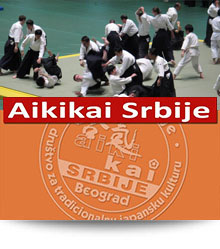In search of thecnique
Cath Davies, 4th Dan so Hombu, UKA Fukushidoin
UKA newsletter, printed April/May 2001
 How many times do we stop half way through a technique because we realise that the technique that we were trying to do isn't going to work? Perhaps we have been wrong footed or perhaps the uke has attacked gyaku hanmi and we were expecting ai hanmi.
How many times do we stop half way through a technique because we realise that the technique that we were trying to do isn't going to work? Perhaps we have been wrong footed or perhaps the uke has attacked gyaku hanmi and we were expecting ai hanmi.
Unfortunately, the structure of most classes encourages this: the instructor has shown shomenuchi ikkyo and so that's what we're doing. Never mind that due to a variety of circumstances, ikkyo may be the least likely or possible outcome of any given encounter. It's what we're doing and we're going to make it work no matter what!
Of course, this type of practice is vital. It is how we begin to learn. The instructor structures a class with a view to leading the student in a natural progression. The student needs time to practise each technique over and over and, in so doing, to gain a physical understanding of what makes the technique work.
This practice of kata (form) is very necessary if we are to move onto further stages. Thinking of the principles of shu (keeping form), ha (breaking form) and ri (parting from form), it should be noted that the first stage, shu, is the level at which one should practice until sandan. Speaking from a personal point of view, I am finding this to be true and am aware of how much work I still need to do on the form. It is a sobering thought!
The following quote by Terry Dobson, taken from "It's a lot like dancing ... an aikido journey" *, explains allegorically something of shu, ha, ri:
It's a lot like dancing. The more time and energy you spend on learning the steps, the less you enjoy the dance.At the same time,if you don't know the steps and you're all enjoyment, you're not very artistic In approaching the art, each of us has to balance learning the steps and enjoying the music. Every teacher teaches in a different way. It seems to me that at the beginning, there's a preoccupation with learning the steps, and I think that's good. But later, it's important to know that the music is critical, too. Just feel the music and get into the feeling of the throw without worrying about the disparate parts. Participate in the flow. Eventually, you have to cut loose of the techniques and let your self go. To do that is scary.
However, irrespective of where we are on the path, it is good to be aware of the stages involved in an encounter (attack and defence) as it enables us to strive towards the next ages if practice, even though they may be some years away. As I see it the stages are:
- Ma-ai. This can be translated as meeting distance or space joining (joining of space). Before uke and tori physically come together, a relationship already exists.
- De-ai. This is the encounter, the meeting. At this moment, tori must make appropriate tai sabaki (body movement).
- Kuzushi. Having evaded the attack, tori must perform kuzushi (balance breaking).
- Waza. Having successfully accomplished all of the above, waza (technique) will be evident.
Of course, these 4 stages happen in a split second and we may, therefore, not always think of them or recognise them as distinct and necessary in their own right. Waza is the end of the process and is only possible when we have created an opening by completing the first 3 stages. This is crucial. We should not begin by deciding that will do shiho nage. We must, in the split second of the encounter, respond to the opening that we have made and do the technique that is waiting for us.
To develop this, I find that jyu waza (free practice) is very beneficial. It is much easier to let your body respond naturally to an attack when you are not preoccupied with doing the "right" technique at the end. If it does not matter what happens at the end, you are free to concentrate on the first 3 stages. It is, of course, very important to be relaxed in order to be able to respond to and match uke's movement.
So, in our practice should we be searching for technique? No! The technique will find us if we have correctly trained our minds and bodies in ma ai, de ai and kuzushi.
Cath Davies, Miyo Shin Juku
*It’s a lot like dancing ... an aikido journey", Terry Dobson, Riki Moss, Jan-E Watson. Published by Frog Ltd.
